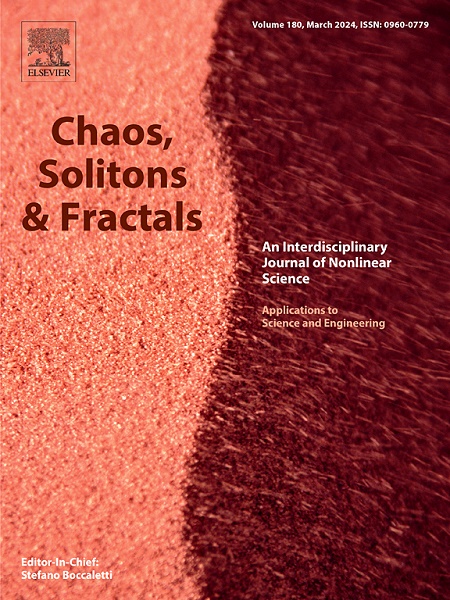双向锁模光纤激光器中纯四次孤子的脉动和蠕动动力学
IF 5.3
1区 数学
Q1 MATHEMATICS, INTERDISCIPLINARY APPLICATIONS
引用次数: 0
摘要
纯四次孤子(PQSs)代表了超快光学领域的重大进步,使高能脉冲的产生成为可能。本文对双向锁模光纤激光器中PQSs的脉动和蠕动动力学进行了系统的数值研究,重点研究了四阶色散(FOD)的影响。通过仔细调整FOD,在顺时针(CW)和逆时针(CCW)传播方向上都观察到PQSs的明显脉动行为。然而,两个传播方向之间的脉动幅度存在显著差异,这主要归因于激光腔内非线性效应和FOD的相互作用。此外,当FOD增加到一定阈值以上时,PQSs开始表现出蠕变行为,其脉冲动力学的特征是周期性的时间位移。重要的是,对爬行距离的精确控制可以通过调整FOD来实现。这项工作还揭示了爬行动力学的复杂方面,包括同步和异步爬行周期等现象。这些发现不仅加深了我们对超快光学的理解,而且为双梳光源的应用提供了理论见解和实践指导。本文章由计算机程序翻译,如有差异,请以英文原文为准。
Pure-quartic soliton pulsating and creeping dynamics in a bidirectional mode-locked fiber laser
Pure-quartic solitons (PQSs) represent a significant advancement in the field of ultrafast optics, enabling the generation of high-energy pulses. This study presents a systematic numerical investigation of the pulsating and creeping dynamics of PQSs in a bidirectional mode-locked fiber laser, focusing on the influence of fourth-order dispersion (FOD). By carefully adjusting the FOD, distinct pulsating behaviors of PQSs are observed in both clockwise (CW) and counterclockwise (CCW) directions of propagation. However, notable differences in the pulsating amplitudes between the two propagation directions are identified, primarily attributed to the interplay between nonlinear effects and FOD within the laser cavity. Furthermore, as the FOD is increased beyond a certain threshold, PQSs begin to exhibit creeping behavior, characterized by periodic temporal shifts in their pulse dynamics. Importantly, precise control over the creeping distance can be achieved by tuning the FOD. This work also reveals intricate aspects of creeping dynamics, including phenomena such as synchronized and asynchronous creeping periods. These findings not only deepen our understanding of ultrafast optics but also provide both theoretical insights and practical guidance for the application of dual-comb light sources.
求助全文
通过发布文献求助,成功后即可免费获取论文全文。
去求助
来源期刊

Chaos Solitons & Fractals
物理-数学跨学科应用
CiteScore
13.20
自引率
10.30%
发文量
1087
审稿时长
9 months
期刊介绍:
Chaos, Solitons & Fractals strives to establish itself as a premier journal in the interdisciplinary realm of Nonlinear Science, Non-equilibrium, and Complex Phenomena. It welcomes submissions covering a broad spectrum of topics within this field, including dynamics, non-equilibrium processes in physics, chemistry, and geophysics, complex matter and networks, mathematical models, computational biology, applications to quantum and mesoscopic phenomena, fluctuations and random processes, self-organization, and social phenomena.
 求助内容:
求助内容: 应助结果提醒方式:
应助结果提醒方式:


